Palladium
Palladium Network: Innovation in Risk Management and Portfolio Diversification
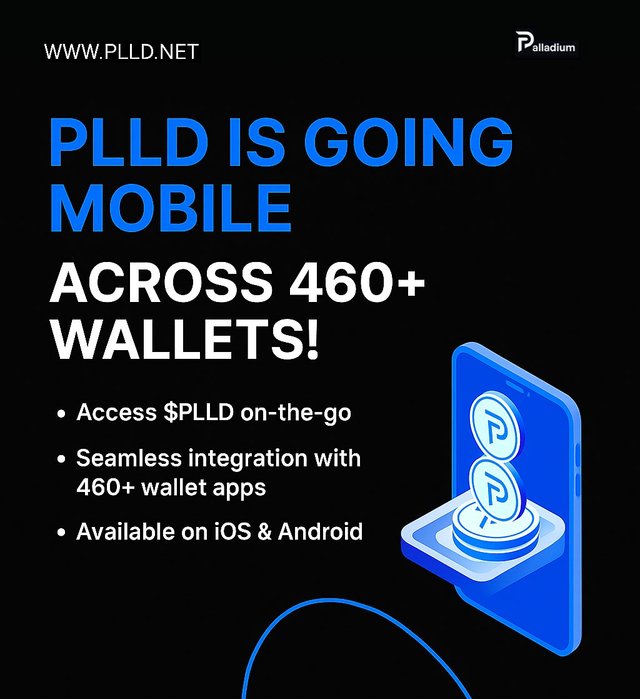
GwYfwhMX0AAvHfm.jpg
Introduction
In the ever-evolving financial landscape, investors are constantly seeking innovative strategies to manage risk and enhance portfolio diversification. The Palladium Network has emerged as a leading platform, offering a breakthrough in risk management and portfolio diversification through the use of blockchain technology and the tokenization of real-world assets. This article explores how the Palladium Network is revolutionizing risk management and portfolio diversification, highlighting its mechanisms, benefits, and potential impact.
Palladium, a hybrid system that combines real-estate–backed NFTs with an automated arbitrage engine to offer stable returns and reduced volatility in digital markets. By tokenizing select properties and channeling a portion of arbitrage profits into buybacks of Palladium's native token (PLLD), the platform provides both tangible asset security and liquidity advantages. This litepaper outlines the tokenization models, buyback mechanisms, vesting schedules, and the architectural foundations designed to democratize premium real estate ownership while incentivizing rational market behavior. Palladium converges tangible real estate value with high-frequency arbitrage to produce a more stable and transparent blockchain environment. Through fractional NFTs, investors gain direct access to income-generating properties, while arbitrage-driven buybacks anchor PLLD's market performance. This unified approach aims to diminish speculation, expand market liquidity, and democratize prime real estate investment—offering participants a balanced, sustainable path forward in the digital asset realm.
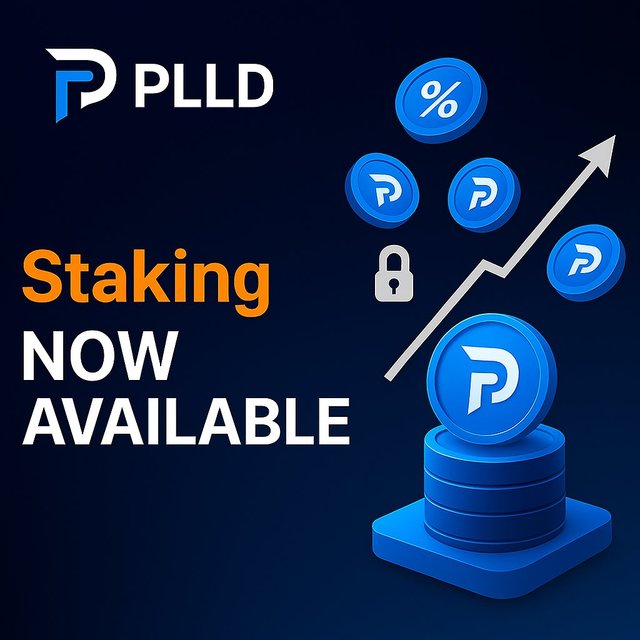
How Palladium's Hybrid Model Works
1. Real Estate–Backed NFTs
Traditional real estate investment often requires significant capital, legal hurdles, and long holding periods. Palladium solves this by tokenizing property fractions into NFTs.
For example, its first property—a scenic mountain cottage near a ski resort—is being tokenized and offered to the community. Investors don't need millions to own a luxury property; instead, they can purchase fractional NFTs that represent their share.
Each NFT is tied to a real-world, income-generating property, ensuring that investors benefit not only from property appreciation but also from rental income and ecosystem rewards.
2. Automated Arbitrage Engine
Crypto markets are known for price inefficiencies across exchanges. Palladium leverages this by deploying a high-frequency arbitrage engine that scans and exploits price gaps.
Here's the key part: a portion of profits from arbitrage is used to buy back PLLD tokens from the market. This constant buyback mechanism reduces circulating supply, anchors token value, and incentivizes long-term holding.
3. Buyback and Burn Mechanism
To further stabilize the ecosystem, Palladium channels arbitrage profits into buybacks of PLLD. Some of these tokens are burned, while others are redistributed to loyal community members through rewards and staking pools.
This system reduces volatility while rewarding long-term holders—creating a win-win environment for both investors and the token economy.

Traditional Challenges in Risk Management and Portfolio Diversification
Risk management and portfolio diversification are essential components of a successful investment strategy. However, traditional approaches have limitations:
- Limited Access: Retail investors often have limited access to certain investment opportunities, such as real estate or other alternative investments.
- Liquidity: Traditional assets, such as real estate, can be illiquid, making them difficult to buy or sell quickly.
- Costs: Traditional investments can incur high costs, such as transaction fees, management fees, and performance fees.
- Lack of Transparency: Some traditional investments are opaque, making it difficult to track performance and understand risks.
- Correlation: Traditional assets can be correlated, reducing the benefits of diversification.
Palladium Network: An Innovative Approach
The Palladium Network addresses these challenges by offering an innovative approach to risk management and portfolio diversification:
- Asset Tokenization: The Palladium Network enables the tokenization of real-world assets, such as real estate, commodities, and securities. These tokens can be traded on decentralized exchanges, giving investors access to new markets and increasing liquidity.
- Fractional Ownership: Tokenization fraction enables ownership of assets, allowing investors to invest with smaller capital and diversify their portfolio across multiple assets.
- Transparency: Blockchain provides greater transparency than traditional financial systems. All transactions are recorded on a public blockchain, allowing investors to track performance and understand risks.
- Lower Fees: DeFi platforms are often cheaper than traditional financial systems, as intermediary fees are eliminated.
- Accessibility: The Palladium Network makes investing more accessible to a wider audience.
- Uncorrelated Assets: The Palladium Network offers access to assets that are unrelated to traditional markets, such as real estate, which can help to reduce portfolio risk.
Benefits of the Palladium Network for Risk Management and Portfolio Diversification
- Increased Diversification: The Palladium Network allows investors to diversify their portfolios across multiple assets, reducing risk and increasing potential returns.
- Increased Liquidity: Tokenization increases the liquidity of assets, making them easier to buy and sell quickly.
- Lower Fees: The Palladium Network offers lower fees than traditional investments, increasing returns.
- Increased Transparency: Blockchain provides greater transparency, allowing investors to track performance and understand risks.
- Greater Accessibility: The Palladium Network makes investing more accessible to a wider audience.
- Risk Reduction: The Palladium Network helps to reduce portfolio risk by offering access to assets that are unrelated to traditional markets.
Example: Real Estate Diversification with the Palladium Network
Traditionally, real estate investments require significant capital and can be illiquid. The Palladium Network allows investors to invest in real estate with smaller capital through fractional ownership of real estate tokens. This allows investors to diversify their portfolios across multiple properties, reducing the risks associated with single-property investments.
Risk Management Strategy on the Palladium Network
- Due Diligence: Conduct thorough due diligence on tokenized assets before investing.
- Diversification: Diversify your portfolio across different assets and asset classes.
- Position Size: Manage your position size to limit potential losses.
- Stop-Loss Order: Use a stop-loss order to limit potential losses.
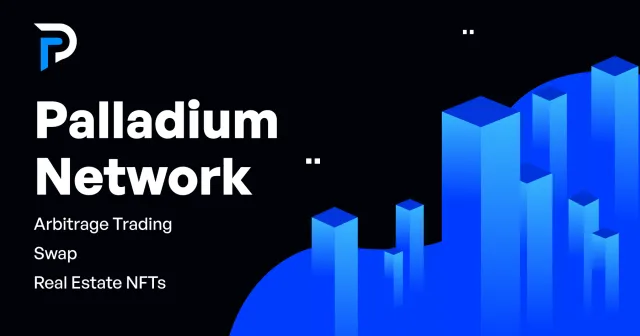
Tokenomics
Palladium's native token, PLLD, has a fixed supply of 100,000,000. Distribution is designed to fuel development, liquidity, and community incentives:
- Liquidity Provision - 30%- 30,000,000- Market making on CEX/DEX
- Public Sale - 20%- 20,000,000- Token Generation Event (TGE)
- Development - 20%- 20,000,000- Platform enhancements, arbitrage R&D
- Team & Advisors - 10%- 10,000,000- Vesting ensures long-term alignment
- Treasury Reserve - 10%- 10,000,000- Buffer for strategic needs
- Marketing - 10%- 10,000,000- Growth & partnerships
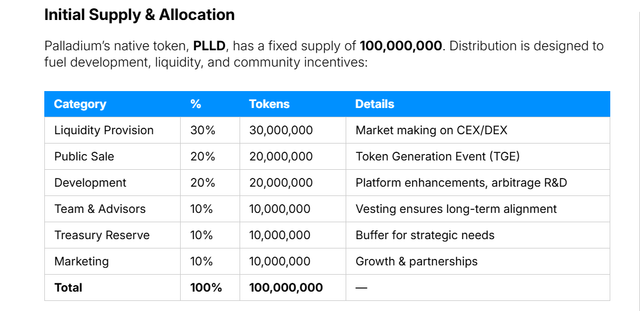
Screenshot_5.png
Vesting Schedules
Development (20%)
- Lockup: 6 months post-TGE
- Vesting: Gradual release from Month 7 onward, aligning with platform milestones (eg, Swap launch, real estate tokenization).
Team & Advisors (10%)
- Lockup: 6 months post-TGE
- Vesting: Linear over 25 months to maintain focus on long-term success.
Treasury Reserve (10%)
- Lockup: 12 months post-TGE
- Vesting: Linear release, offering flexibility for unforeseen requirements and strategic expansion.
Marketing (10%)
- Lockup: None
- Vesting: 25% released at TGE, remaining 75% over the next 12 months to support sustained growth and user acquisition.
These schedules prevent sudden token floods, safeguarding market stability and incentivizing ongoing project development.
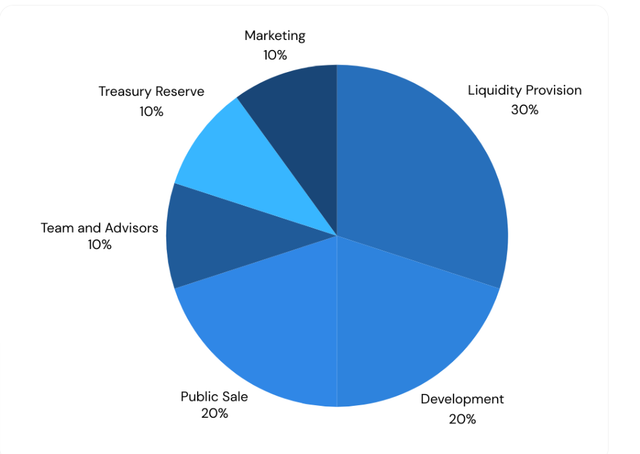
Screenshot_1.png
Buyback Mechanism
Central to Palladium's sustainability is a profit-sharing buyback system, where a portion of PLLD's arbitrage returns fund repurchases:
- Arbitrage Earnings: Profits generated from market inefficiencies are channeled into the buyback pool.
- Periodic Token Buys: At random intervals, Palladium buys PLLD on the open market to thwart predictable front-running and speculation.
- Supply Reduction: Tokens are transferred to the treasury or retired, potentially effectively shrinking circulating supply and supporting the token's market value.
Transparent Reporting" Quarterly disclosures detail total tokens repurchased, expenditure, and transaction references for on-chain or exchange verification.
PLLD Token Utility: More Than Just a Crypto
The PLLD token is central to Palladium's ecosystem, serving multiple purposes:
- Arbitrage-driven buybacks → A portion of profits is used to buy PLLD on open markets, reducing circulating supply.
- Liquidity enhancement → Supporting smoother trading and stability.
- Staking rewards → Holders can lock PLLD for passive income.
- Governance rights → Active community participation in ecosystem decisions.
- Loyalty incentives → Long-term holders benefit from periodic airdrops and bonus rewards.
This dual-stream model—real estate NFTs for property income and PLLD tokens for arbitrage-driven rewards—ensures clarity, transparency, and diversified opportunities.
Roadmap
Phase 1 (0–6 Months)
- Expand arbitrage coverage to multiple exchanges
- Conduct buybacks from initial trading profits
- Complete preliminary audits
Phase 2 (6–12 Months)
- Launch PLLD Swap
- Roll out first fractional real estate NFTs
- Integrate advanced arbitrage (options, futures)
Phase 3 (12+ Months)
- Diversify global property portfolio
- Implement AI-based arbitrage modules
- Maintain ongoing buybacks and periodic vesting updates
The future of blockchain is not about speculation—it's about utility, sustainability, and integration with real-world assets. Palladium Network (PLLD) embodies this shift by converging tangible real estate with high-frequency arbitrage, creating a more stable, transparent, and rewarding ecosystem. For investors seeking real-world backing, consistent rewards, and exposure to premium properties, Palladium is more than just a project—it's a gateway to the next evolution of decentralized finance.
Whether you're a crypto investor, real estate enthusiast, or DeFi explorer, Palladium Network offers a unique opportunity to be part of a balanced, democratized digital economy.
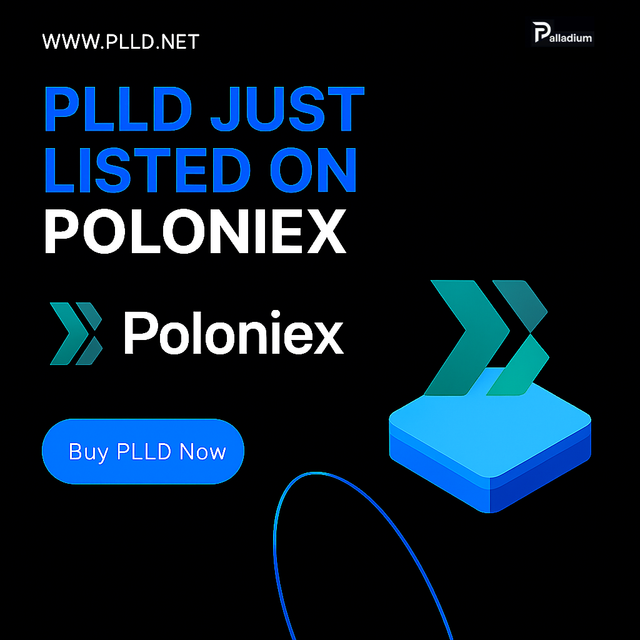
Conclusion
The Palladium Network has an ambitious vision to create a more inclusive and efficient financial future. By harnessing the power of blockchain technology and DeFi principles, the Palladium Network aims to democratize access to financial services, reduce costs, and increase transparency. While there are challenges and risks associated with this platform, the potential benefits of a more inclusive and efficient financial future are substantial.
Stay connected with us:
- Website: https://plld.net/
- Twitter: https://x.com/DDTechGroup
- Telegram: https://t.me/Palladium_PLLD
- Whitepaper: https://plld.net/whitepaper
- View PLLD on CoinGecko: https://www.coingecko.com/en/coins/palladium-network
- Forum Username: Tonnang
- Forum Profile Link: https://bitcointalk.org/index.php?action=profile;u=3357702
Komentar
Posting Komentar